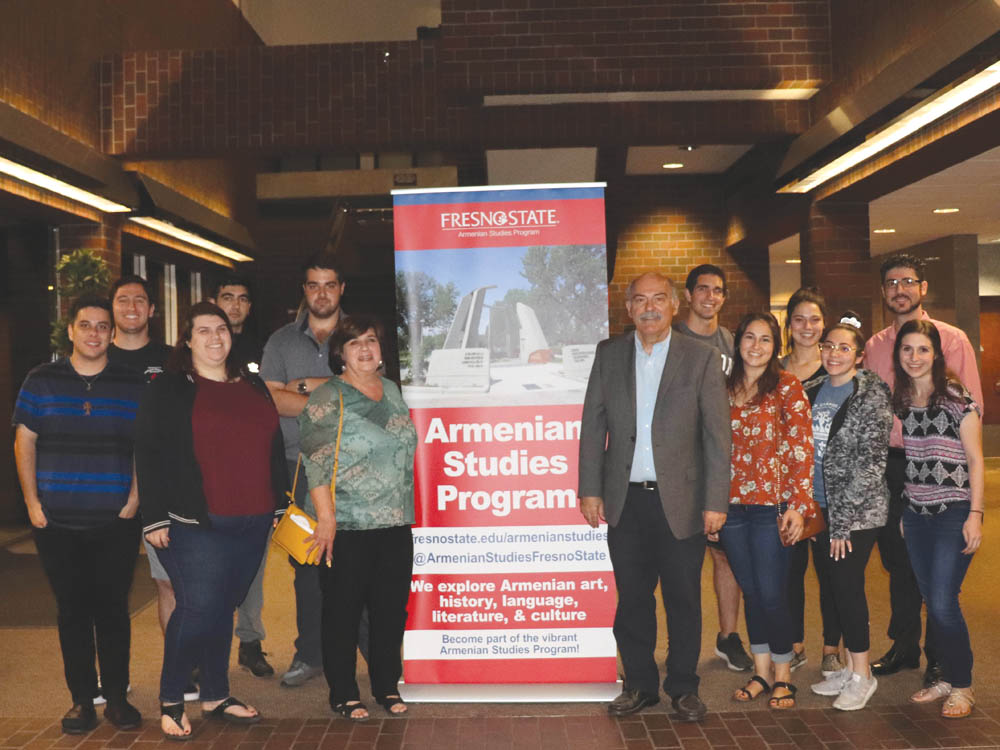
presented the documentary “The Stateless Diplomat” to a
full house in the Fresno State University Business Center.
Malayan is the great-granddaughter of Diana Apcar.
Photo:Andrew Hagopian
Carina Tokatian
Staff Writer
“The more I delved into her [Diana Apcar’s] story, the more I discovered the magnitude of her contribution to Armenia and the Armenian people. And with each discovery, the more awe I felt for this incredible woman,” stated film director and producer Mimi Malayan, who is the great-granddaughter of Diana Apcar.
On Tuesday, October 8, the Armenian Studies Program, the Armenian National Committee, Central California, and the Hamazkayin Taniel Varoujan Chapter sponsored the screening of the 2018 film, “The Stateless Diplomat: Diana Apcar’s Heroic Life.” The event was held in the University Business Center, Alice Peters Auditorium, where Malayan was also present to discuss her great-grandmother’s story.
Diana Agabeg Apcar’s story began in Rangoon, Burma where she was born. As a young woman, she attended a convent in Calcutta, India, until she later returned to Rangoon to marry an Armenian merchant, Michael Apcar. The couple relocated to Yokohama, Japan to pursue greater business opportunities. Unfortunately, in 1906, her husband Michael passed away, and she was left to raise their three children alone, as well as to run the family business. In addition to these responsibilities, Apcar was fascinated with writing and wrote fictional stories such as Susan and Home Stories of the War. She also showed much interest in religion and politics, often inviting political leaders and clergymen to her home for discussions.
When Apcar learned of the 30,000 Armenians massacred in Adana, Turkey in 1909, she changed the focus of her writing. Beginning in 1910, she published books such as The Truth about the Armenian Massacres and Betrayed Armenia. This was followed by six more publications, one of which Apcar’s granddaughter Lucille Apcar published in 2004, called From the Book of 1000 Tales: Stories of Armenia and its people 1892-1922.
In addition to books, Apcar wrote letters to missionaries, ministers, the Red Cross, politicians, presidents, and kings pleading for their support of Armenia. While her skilled writing and rhetoric certainly invoked a sense of urgency, she still faced setbacks. For instance, imperialists and political leaders preferred to preserve the “equilibrium of Europe” by maintaining the Ottoman Turkish Empire’s dominion over Armenians. Yet, Apcar remained determined and soon busied herself with another humanitarian effort—assisting Armenian Genocide refugees who fled to Japan. She sold jewelry and other possessions to pay for ship passages for the refugees and also assisted them in obtaining passports to America.
Apcar also arranged for housing, schools, and jobs for the Genocide victims in the months they were expected to stay in Japan. Furthermore, she searched for refugees’ relatives in order to reunite families and then possibly resettle them in Armenia. She hoped that “Wilsonian Armenia,” U.S. President Woodrow Wilson’s boundary for the newly recognized Republic of Armenia, would become a reality. Unfortunately, “Wilsonian Armenia” never became a reality as Armenia was quickly annexed into Communist Russia in 1920.
Nevertheless, throughout all of this, Apcar’s spirituality had a major impact on her endeavors; she even wrote a prayer for Armenia to be recited in churches. Due to the Great Japanese Kanto Earthquake of 1923, much evidence from Apcar’s life was lost. However, her writings and numerous testimonies of her humanitarian efforts verify the noble legacy she left behind.
Malayan said that she was always aware that there was something special about her great-grandmother, but she did not become passionate about Diana Apcar’s story until 2004 when she discovered one of Apcar’s “lost” writings. As soon as Malayan retired, she delved further into the story and initiated the idea of making a movie about Diana Apcar.
The film utilizes a unique combination of sketched illustrations and real-life footage to depict Apcar’s life. It was originally Malayan’s co-director, Artur Muradyan, who suggested the use of the Japanese scroll effect (illustrated by Lu Ke and edited by Todd Dayton) as a substitute for the limited number of real-life visuals available from Apcar’s life. They also felt it was appropriate, given that she resided in Japan while aiding the Armenians. Along with these illustrations, the film incorporates interviews with scholars and descendants of those who were aided by her.
Additionally, the film’s title is curiously worded, relying on a paradox, “The Stateless Diplomat,” to emphasize how Apcar was appointed as “Honorary Consul to Japan” for barely six months. Japan was not able to officially recognize her before Armenia was annexed. Despite this, it did not seem to matter to Apcar if she served in an official or unofficial capacity. All that mattered was that she served.
Acknowledging how Diana Apcar’s accomplishments have exceeded those of the average person, Malayan’s ultimate goal through the film is to gain recognition of Apcar’s notable achievements. For instance, Malayan recently discovered a newspaper article published in 1920 which recognized Apcar’s assistance to 2,500 people.
Considering that female involvement in political affairs was almost unheard of in the early twentieth century, Apcar certainly left much more than just a mark on the world. Her persistence and selflessness deserve not simply recognition but imitation.
Diana Apcar left an example for us all.
To learn more about Diana Apcar’s story, visit https://dianaapcar.org/.
 Hye Sharzhoom Armenian Action
Hye Sharzhoom Armenian Action